The R/V Thomas G. Thompson left Honolulu on November 5, 2011 heading toward the Western Pacific. This expedition journal was written by cruise participants and uploaded about once per weekday, depending on internet availability.
December 1, 2011: Beyond the Classroom
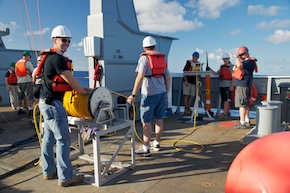
Maggie goes out (Credit: Will Koeppen)
By the time we reach Guam, our young scientists (the five from Kutztown University and three recent college graduates) will have stood watch in shifts, four on eight off, 24-hours a day for 40 days, combatting sleepiness, seasickness and occasional lack of excitement. They have been plucked from home, dropped off in the middle of nowhere (check out our location on Google Maps), and separated from friends and family, smart phones, TV, and high-bandwidth internet for six weeks. So, why did we do this to them, and is it worth the hassles of paperwork and arranging their schedules to remove them from campus for the five weeks of the semester (to name a few)? Having lived through the process that got all of us out here I will say, without a moment of hesitation, yes, yes, most emphatically yes. It is worth it.
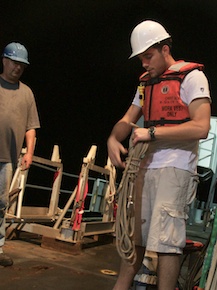
Ropework (Credit: Will Koeppen)
One of the major goals of our research proposal funded by the National Science Foundation was to expose young scientists to field oceanography and provide them the opportunity to participate in cutting edge research with scientists in all stages of their careers. The five students from Kutztown are participating in the Jurassic Ocean Crust Magnetic Survey as geophysical watchstanders. But because the students are receiving three KU credits (either as research or an internship) for their time on the research cruise, I want to expand on what they are doing out here and how it contributes to, and even enhances, their undergraduate education. If you have been following our blog, you know about this experience from the student perspective, but here is mine, as their professor.
As the watchstanding logs pile up the students are starting to realize why it is that they record so much information that at first glance doesn’t always appear to be useful. They mentioned to me the other day that the important difference between ship heading (which way the bow is pointing) and course over ground (direction in which we are moving) became clear when they realized the ship was traveling down our survey line backwards and little sideways! These concepts lose something when taught in the classroom.
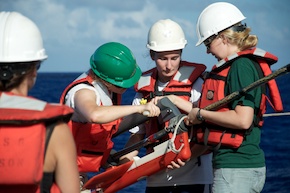
Deploying seismic gear (Credit: Will Koeppen)
In addition to their duties staring at screens in the computer lab, the watchstanders help to deploy and retrieve scientific instruments and vehicles, assist in data reduction and processing, and attend science briefings given by the chief scientists. All of the students have clocked several hours of deck time launching and recovering seismic gear and the surface magnetometer and helping to repair the seismic streamer during “cable parties.” During seismic operations the watchstanders assist in monitoring data acquisition and keeping constant radio contact with the protected species observers on deck. They also help us launch sonobuoys every 2.5 hours, which consists of throwing the buoy in its metal housing as far as possible away from the boat while keeping radio contact with the bridge and lab. The students have learned to plot the ship’s hourly position in ArcGIS as well as by hand on large charts. In one instance, plotting hourly position by hand allowed the watchstanders to catch and then correct an important navigation error. They are also responsible for creating important daily reports of the geophysical data, which are used by the chief scientists and Sentry team to plan AUV dives, refine survey waypoints, and make initial interpretations.
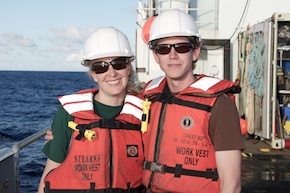
We edit this thing (Credit: Tom Bond)
Do they sound busy enough? And yet, there’s more. The KU students have to find time to do homework, labs and even exams while on board the Thompson (the post-graduates sigh with relief that they do not have to do homework). The KU students each write one blog per week on a variety of topics including the goals of the research, scientific theory, the technology used on board, as well as their personal experiences at sea. The students are learning scientific reporting from me and Dr. William Koeppen. This type of writing is extremely challenging and most had not been exposed to it before this cruise. We have certainly seen improvement in the students’ writing since the beginning of the cruise. They are gaining the ability to understand technical subjects and make them accessible to the general public. In working on the Jurassic Quiet Zone/Magnetics two-part blog—the most challenging as of yet—Jen, Nick and Tom are reading scientific papers by chief scientists Dr. Masako Tominaga and Dr. Maurice Tivey and talking to them about their research. The students are attempting to explain the goals of this cruise in a way that, as Jen put it, her mom would like to read.
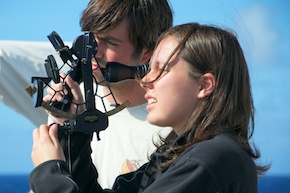
Using a sextant (Credit: Will Koeppen)
In living and working on a ship, the students are also learning from the crew aboard the R/V Thompson. The watchstanders stood bridge watches under the supervision of the captain and mates to see the interplay of scientific operations with ship operations and navigation. In the pilot house they “drove” the ship, plotted the course and calculated distances, learned about the ship’s radar systems, and spent quality time with those in charge of the Thompson. Captain Patrick Donovan gave a lecture and demonstration on celestial navigation by sextant. Some of our future blog topics involve ocean engineering, water production and waste management on board. These blogs require the students to interview the crew and tour the engine rooms, incinerator and other usually restricted areas of the ship. Because of these opportunities, the students are able to learn what goes into making our water run, lights work, toilets flush, and all of the other day to day activities that we take for granted on board.
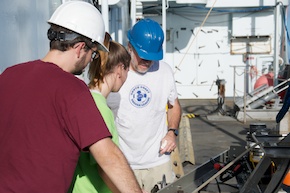
Learning from giants (Credit: Will Koeppen)
The cruise provides an incredible networking experience for our students. Because this research involves many different components (AUV-Sentry, multi-channel seismics, seismic refraction, towed magnetometers, protected species observation) the students are working with scientists, graduate students and technical experts from across the US. They are directly involved in cutting-edge science that pushes the limits of current technology, working in one of the most remote regions of the planet. They are witnessing the work that goes into designing a successful oceanographic survey, and gaining an understanding of the challenges of doing research at sea (e.g. bad weather, system malfunctions, troubleshooting deep-sea communications and navigation).
In short, they are learning much more than I could ever have taught them on campus. In fact, I feel like I personally contribute a very small part of their education out here. Their knowledge will exceed mine in various subjects (such and the ins and outs of the AUV-Sentry) and they can start teaching me. And isn’t that the ultimate goal of education? ♦
